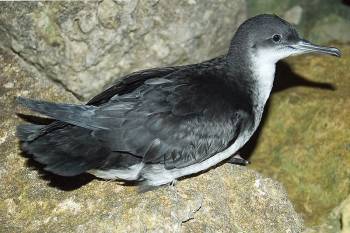Teresa Militão (Departament de Biologia Animal (Vertebrats), Universitat de Barcelona, Spain) and colleagues, writing in the journal Diversity and Distributions, discuss the migratory patterns of Balearic and Mediterranean Shearwaters utilizing stable isotopes and geolocation.
The paper's abstract follows:
"Aim Intraspecific variability in the migratory movements of seabirds is being revealed far more complex than hitherto recognized, and our lack of understanding undermines their effective protection. Our aim is to test whether the isotopic values of a single feather of two threatened seabirds, the Mediterranean (Puffinus yelkouan) and the Balearic (Puffinus mauretanicus) shearwaters allow the geographic assignment of birds to their non-breeding areas.
Location These two species are known to use three main non-breeding areas: the NE Atlantic Ocean, the W Mediterranean and the Aegean-Black seas.
Methods We clustered in three groups the d13C and d15N values of the first primary feather (P1), inferred to be grown during the non-breeding period, of 34 Mediterranean and 56 Balearic shearwaters accidentally caught by longliners. To link the isotopic values of P1 to its corresponding non-breeding area, we performed a discriminant function analysis (DFA) based on the three clusters and applied this function to feathers of known origin: P1 from seven Mediterranean shearwaters from Hyères Archipelago (France) tracked with geolocators and body feathers from six chicks from Balearic shearwaters. To link the moulting patterns to the areas where the feathers were grown, we applied the DFA to a sequence of primary feathers of eight Balearic and five Mediterranean shearwaters (caught by longliners).
Results Isotopic and tracking data indicate that none of the Mediterranean shearwaters migrated to the Atlantic. The cluster and discriminant function analyses revealed that 8% of Balearic and 54% of Mediterranean shearwater moulted P1 in the Mediterranean Sea. Migratory movements were reflected in the changing isotopic values of the primary sequences.
Main conclusions Stable isotope analyses (SIA) are a powerful approach to reveal the intraspecific variability in the migratory patterns of seabirds that use distinct isotopic areas over their annual cycle. The assignment of birds to their non-breeding areas by means of SIA is a simple and effective tool that can help to evaluate the impact of human activities in remote areas not only at population but also at individual level, which is an essential knowledge for the management and conservation of threatened species."
The Yelkouan Shearwater breeds on Malta
Photograph by Matthew Borg Cardona
Reference:
Militão, T., Bourgeois, K., Roscales, J.L. & González-Solís, J. 2012. Individual migratory patterns of two threatened seabirds revealed using stable isotope and geolocation analyses. Diversity and Distributions. DOI: 10.1111/j.1472-4642.2012.00916.x.
John Cooper, ACAP Information Officer, 2 October 2012

 English
English  Français
Français  Español
Español 